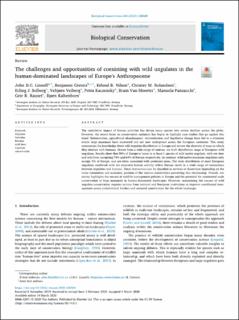| dc.contributor.author | Linnell, John Durrus | |
| dc.contributor.author | Cretois, Benjamin | |
| dc.contributor.author | Nilsen, Erlend Birkeland | |
| dc.contributor.author | Rolandsen, Christer Moe | |
| dc.contributor.author | Solberg, Erling Johan | |
| dc.contributor.author | Veiberg, Vebjørn | |
| dc.contributor.author | Kaczensky, Petra | |
| dc.contributor.author | Van Moorter, Bram | |
| dc.contributor.author | Panzacchi, Manuela | |
| dc.contributor.author | Rauset, Geir Rune | |
| dc.contributor.author | Kaltenborn, Bjørn Petter | |
| dc.coverage.spatial | Europa, Europe | en_US |
| dc.date.accessioned | 2020-10-23T10:20:25Z | |
| dc.date.available | 2020-10-23T10:20:25Z | |
| dc.date.created | 2020-03-17T12:37:04Z | |
| dc.date.issued | 2020 | |
| dc.identifier.citation | Biological Conservation. 2020, 244:108500 1-12. | en_US |
| dc.identifier.issn | 0006-3207 | |
| dc.identifier.uri | https://hdl.handle.net/11250/2684725 | |
| dc.description.abstract | The cumulative impact of human activities has driven many species into severe declines across the globe. However, the recent focus on conservation optimism has begun to highlight case studies that go against this trend. Reforestation, agricultural abandonment, reintroduction and legislative change have led to a situation where large mammals have recovered and are now widespread across the European continent. This study summarizes the knowledge about wild ungulate distribution in Europe and review the diversity of ways in which they interact with humans. Drawn from a wide range of sources, we built distribution maps of European wild ungulates. Results show that 90% of Europe is home to at least 1 species of wild native ungulate, with roe deer and wild boar occupying 74% and 64% of Europe respectively. In contrast, wild native mountain ungulates only occupy 5% of Europe, and are often associated with protected areas. The wide distribution of most European ungulates combined with the extensive human activity within Europe result in a wide range of interactions between ungulates and humans. These interactions can be classified as services or disservices depending on the value orientation and economic position of the various stakeholders perceiving this relationship. Overall, our survey highlights the success of wildlife management policies in Europe and the potential for continental scale conservation of large mammals in human-dominated landscapes. However, maintaining the success of wild ungulate conservation requires actions from national and European institutions to improve coordinated management across jurisdictional borders and sectorial coordination for the whole landscape. | en_US |
| dc.language.iso | eng | en_US |
| dc.rights | Navngivelse 4.0 Internasjonal | * |
| dc.rights.uri | http://creativecommons.org/licenses/by/4.0/deed.no | * |
| dc.subject | Ungulate | en_US |
| dc.subject | Cervidae | en_US |
| dc.subject | Bovidae | en_US |
| dc.subject | wild boar | en_US |
| dc.subject | Caprinae | en_US |
| dc.subject | conservation | en_US |
| dc.title | The challenges and opportunities of coexisting with wild ungulates in the human-dominated landscapes of Europe's Anthropocene | en_US |
| dc.type | Peer reviewed | en_US |
| dc.type | Journal article | en_US |
| dc.description.version | publishedVersion | en_US |
| dc.rights.holder | © 2020 The Authors. | en_US |
| dc.subject.nsi | VDP::Mathematics and natural scienses: 400 | en_US |
| dc.subject.nsi | VDP::Matematikk og Naturvitenskap: 400::Zoologiske og botaniske fag: 480 | en_US |
| dc.source.pagenumber | 1-12 | en_US |
| dc.source.volume | 244:108500 | en_US |
| dc.source.journal | Biological Conservation | en_US |
| dc.identifier.doi | 10.1016/j.biocon.2020.108500 | |
| dc.identifier.cristin | 1802029 | |
| dc.relation.project | Norges forskningsråd: 251112 | en_US |
| cristin.ispublished | true | |
| cristin.fulltext | original | |
| cristin.qualitycode | 2 | |

